Previous Chapter 7 - Prelude to Terrorism Next Chapter 9 - E Company - The Middle Years - the 80s
Chapter
8 – E Company - The Early Years (1970s)
Attrition
The
British government started to wear down the terrorists in 1971
with the catchphrase, ‘An acceptable level of violence’. It
would be another six years before the IRA started their war of
attrition by adopting the principle of ‘The Long War’.
The
catchphrase, ‘An acceptable level of violence’ was first
coined by Reginald Maudling in December 1971 and repeated by
others such as William Whitelaw many years down the line. They
upstaged the Republican murder strategy from the onset. That
catchphrase expressed the mind-set of the British government.
They were prepared to accept a certain level of violence from
the IRA. That undermined the value of violence as a tactical
weapon.
The
IRA’s ‘Cutting Edge’ Philosophy
The
IRA’s murder campaign was designed to influence world
opinion, wear down British resolve and maintain a limited
Loyalist terrorist backlash. The IRA plan was not designed to
coerce the people of Northern Ireland into a United Ireland; it
was indirectly trying to coerce the British government into
uniting Ireland. This was the ‘cutting edge’ philosophy of
Adams in application, the Armalite forcing the political
demands. The whole community of Northern Ireland were hostages,
held to ransom by the IRA and murdered by them at the rate of
two each week. They were showing the world that Northern
Ireland was a failed democracy and political changes had to
take place. The IRA leadership was saying to the British
government, “We have not gone away you know. Start
legislating for our United Ireland and we will stop killing”.
The IRA leadership had the capacity to increase the
killing rate but they were on a ‘knife-edge’. An increase
in the killing rate would have resulted in a civil war that
nobody would have won. IRA violence failed to wrest major
concessions from the British government because they were also
on a ‘knife- edge’.
Although the British government showed scant regard for
the Unionist politicians, the first Ulster Workers Council
strike in 1974 delineated the line they could not cross without
raising Unionist and Loyalist wrath.
The IRA activist always went to ground until the
Loyalist ‘tit-for-tat’ attacks were taken out on the
general Roman Catholic population. These Loyalist sectarian
attacks promoted the idea that the Roman Catholic community
needed the protection of the IRA. That way, the whole
population of Northern Ireland were hostages to all the ‘mad
dogs’ of Irish politics for the next thirty years.
In these early years the symbiotic relationship between
politics and murder cut away the middle ground and polarised
Northern Ireland society. There was a continual movement of the
population and the former ghettos were transformed into
enclaves controlled by terrorists.
Internment
9 August 1971
“If
ever there was validity in the term ‘a pivotal moment’ this
was it. Unrest and civil disturbances had reached intolerable
levels and political uncertainty coupled with pressure from
Westminster and Dublin was not helping. We all felt something
had to be done and while we were still in a relatively
embryonic state in terms of our operational status and
capabilities, nevertheless we were willing to do whatever was
necessary to help bring peace, stability and normality to our
daily lives.
Most
of us thought events were going downhill so fast there would be
civil war which would probably be very bloody but short lived
and then we could get on with the rest of our lives. How wrong
we were. We were only at the beginning of what was to become
‘the long war’ and none of us ever dreamt at that time that
it would take another 30 plus years of terrible violence before
we could see an end.
In
the early hours of 9 August 1971 the RUC and Army carried out
arrest operations of suspected IRA men across the Province,
which led to the introduction of internment. Most of these
arrests were carried out while the suspects were still in bed
and involved breaking down the doors of many of the houses
where the suspects were sleeping. This naturally provoked the
families and caused immense resentment in entire communities
especially as the suspects were then taken away to face harsh
questioning and detention without trial. The violence on the
streets, which followed these arrests, was immense and
widespread. Even more important was the impact and loss of face
suffered by the Official IRA. Although we did not realise it at
the time, nor did we fully appreciate the leadership struggle
and dissention, which was going on in the ranks of the IRA, the
net result of all these events led to hundreds of Republicans
joining the Provisional IRA. By the end of 1971 the Provisional
IRA had not only grown in strength immensely but had also
acquired substantial quantities of weaponry.
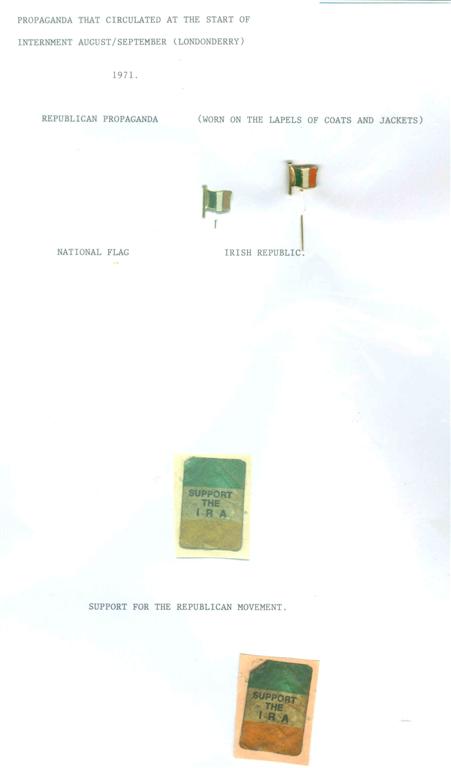
Collar badges popular for catching the fingers of searchers
The
entire UDR was ‘called out’ for full time service by the
GOC Northern Ireland for operations is support of the police
and army. We relished the prospect of being able to do
something constructive and we all felt we had a duty to leave
our jobs, don our uniforms and get on with soldiering to help
protect the decent law abiding citizens from the widespread
violence, which was practically out of control in many areas.
After
receiving a call from CSM John Kerr early that morning to get
my uniform on and get in as quickly as possible, I recall
arriving at our base in Macosquin to report for duty having
left work and family hurriedly and not knowing what was in
store. My mother quickly made me some sandwiches and a flask of
coffee and warned me to be careful as she stood watching me
leave. I knew she had tears her eyes. Naturally I assured her
that I would be fine and that she needn’t worry.
On
reaching Macosquin it was a classic case of ‘hurry up and
wait’. More men were arriving and there was a great deal of
speculation about where we were going and what we would be
doing. Then the OC arrived after having been at Battalion
Headquarters and got all the men to sit down in front of him
while he briefed us. There was no fuss or drama as he gave his
orders. We were then deployed 24 hours a day on a 12 hour shift
system for a variety of patrols, static guards and vehicle
check points over a continuous six week period.
Our
operations were mostly based on the Border in the Londonderry
enclave and consisted of VCPs and some static guards including
guarding Magilligan Camp, which was to become an interrogation
centre for detainees. After the initial excitement and as we
settled down into a routine it became second nature to us as we
carried out our duties including travelling to and from the
various locations around Londonderry in support of 22 Regiment
RA.
Photo 25 CO 22 Regiment RA visiting E Company patrol in Londonderry City
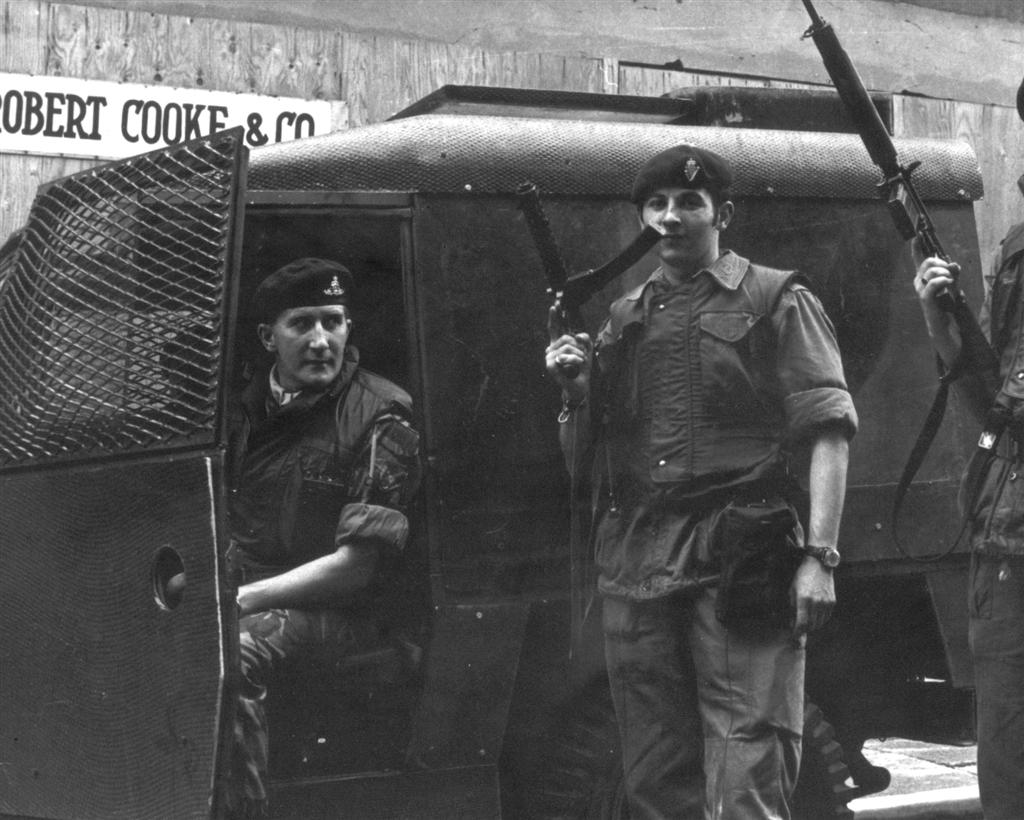
Courtesy Cards
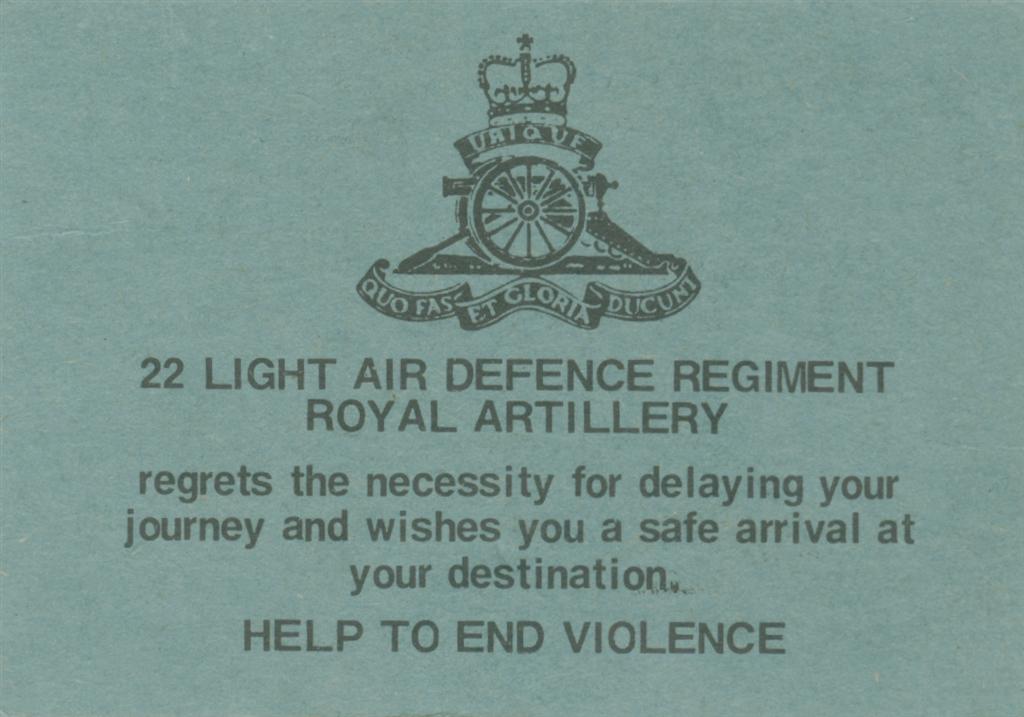
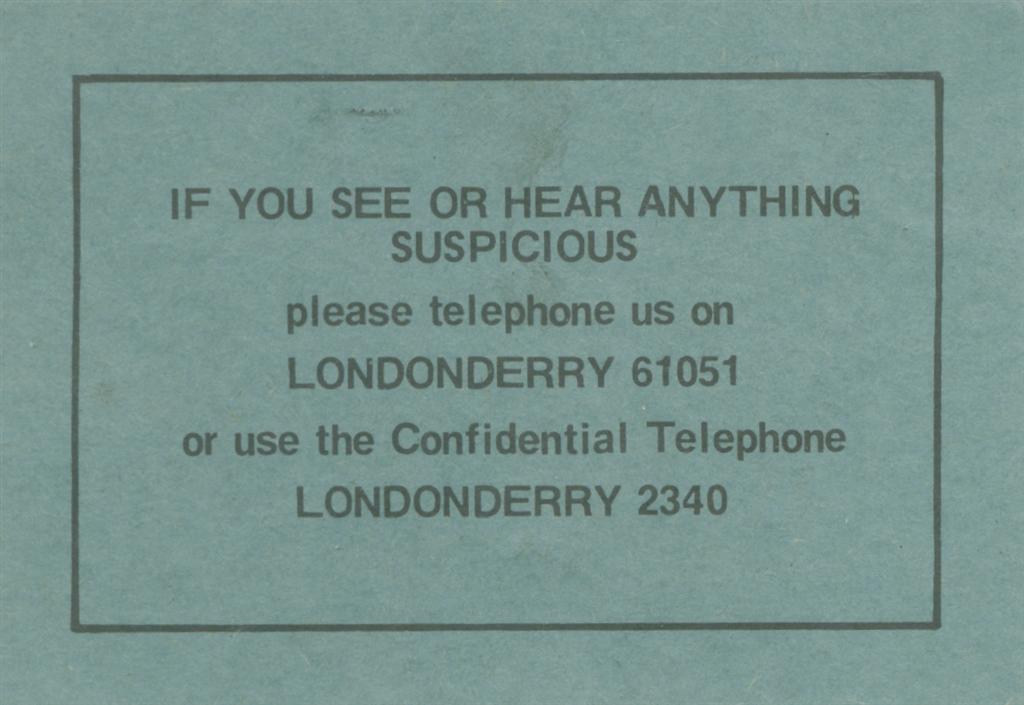
We
survived all weathers, even though it was August, in our olive
green combat gear and even more surprising we managed to live
‘in the field’ with very limited support from either
Company HQ or Battalion HQ. Many locals were quite friendly to
us and brought us goodies such as tea and cake or sandwiches.
These were a welcome change to the doubtful looking stew and
tea made with condensed milk sometimes delivered to us by the
CQMS. I remember being at Battalion HQ on one occasion when
huge containers of stew were being made inside a tent within
Ebrington Barracks and that confirmed my opinion that it was
indeed a doubtful delicacy. Some locals were decidedly
unfriendly to us and clearly resented our presence. Mostly, we
found that by being firm and as polite to them as possible made
them realise that we were not going to rise to their insults
and they eventually cooperated in a silent and sullen manner.
In
between visiting static guards, manning VCPs for long periods
and regular stints as Battalion Orderly Officer, usually for 12
hours at night, a duty which was even more demanding, I was
allowed to go home on a few occasions to wash, catch up on some
sleep and return to duty supposedly suitably refreshed.
Most of the soldiers did the same, as their hours on
duty were either day shift or night shift except on the odd
occasion when shifts extended to 18 hours or so. This happened
due the threat, sometimes the unavailability of transport for
relief or the routes that had to be taken because of rioting or
incidents in the city. There were few complaints if any about
the arduous conditions we endured, as this was what we had all
joined to do.
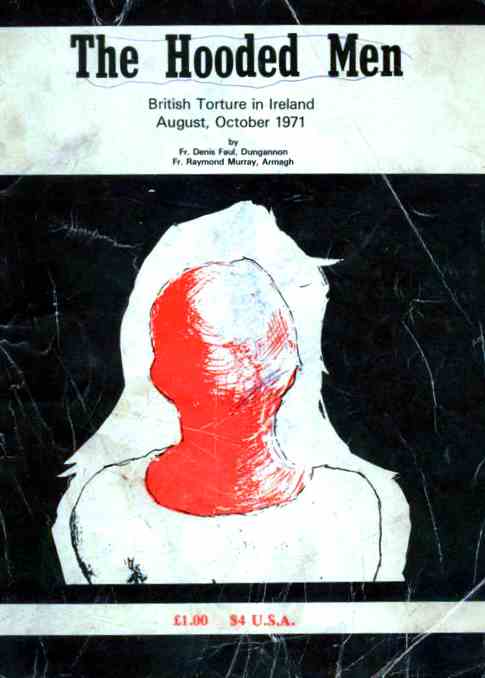
The Banned Book
One
sunny afternoon at Fanny Wylie’s Bridge Ballyarnett some of
our soldiers manning a checkpoint were fired on from a low
ridge about 300 meters away. Fire was returned and this caused
great excitement although no hits were claimed. Fortunately
there were no casualties amongst our men. When I arrived at the
scene a short time later one of the NCOs was holding a small
branch, which had been hit by incoming rounds and had fallen on
his head. This incident sharpened our minds beyond all doubt
that we needed to keep alert at all times and be prepared for
action.
Eventually
the ‘call out’ ended after six tough weeks and we returned
to our families, civilian jobs and the normal routine of
nighttime patrols and guards. We had all learned a lot and it
had been a real test of stamina and resolve. We had become an
even closer knit Company and a much more cohesive band of
‘brothers in arms’.
In
the aftermath of those days and weeks there was an enormous
increase in terrorist activity including the establishment of
No-Go areas. As the Official IRA faded gradually into relative
insignificance, the Provisional IRA became very well organised
throughout the Province and became a highly potent and
aggressive terrorist organisation. The ‘war’ began in
earnest. Even at that stage we thought it was not going to last
long.
How
wrong we were again” (Hamill, 2007).
Anti-Internment
Rallies
Magilligan
22 January 1972
An
Anti-Internment rally was held on Magilligan strand on 22
January 1972. A training day was being held at E Company
location on that day. This was cancelled and the company was
deployed on the periphery of the containment operation. The
Parachute Regiment were deployed on the front line and
successfully dispersed the crowds.
Londonderry
30 January 1972
That same month, on 30 January
1972, 20,000 people took part in a banned march in Londonderry
city. It was a protest against internment and had been
organized by the NICRA. The route towards Guildhall Square was
blocked by the Regular army at William Street. This channelled
the protesters into the Bogside where they assembled at
"Free Derry Corner".
The Regular army then carried out a cordon operation
that trapped the protesters on waste-ground between the Flats
and William Street. The troops were shot at on at least one
occasion before the Paras main assault on the rioters took
place. A Roman Catholic priest reported seeing a civilian
carrying a handgun during one of the shooting incidents. One
civilian was shot and died later before the Paras were deployed
(Doherty, 2007)
The Paras were ordered in to arrest rioters and as that
operation began they shot and fatally wounded thirteen known
civilians. That one incident alone accounted for more civilian
deaths than the persistently maligned B Specials had ever been
accused of in their 50 years of loyal service.
“One officer and 25 soldiers from E
Company were manning the Permanent Vehicle Check Point (PVCP)
on the Letterkenny Road that day. I was the radio operator and
as soon as the shooting started I monitored all the frequencies
in the city with my C42 radio to determine what was happening.
Despite the horror of the situation all the operators followed
proper radio procedure.
The PVCP was very busy when the shooting
stopped, in that many ambulances, including the Knights of
Malta passed through. Many people were injured and they were
treated in the Republic of Ireland.
One hour after the shooting stopped the area was very
quiet. There was no animosity from the people going through our
PVCP, which was strange. We were stood down by the resident
battalion at approximately 5pm and went for a meal in Ebrington
Barracks before returning home to Coleraine.
That incident was a turning point as far
as the security forces in Northern Ireland were concerned.
After the incident we had to upgrade our personal security and
patrol tactics in order to stay alive” S36.
Bloody
Sunday was followed by an upsurge in Republican violence. In the three years prior to
the incident six people were being killed each month. For
eleven months after the incident, forty people were killed each
month.
The Stormont devolved government was
suspended on 24 March 1972 by Edward Heath after
Brian Faulkner’s administration refused to transfer the
control of security in Northern Ireland to Westminster. From
that date a Secretary of State for Northern Ireland governed
Northern Ireland along with a team of junior ministers and
civil servants.
Official
IRA Ceasefire
Two
months later, after the terrorist murder of Ranger Best in
Londonderry, the Dublin based leadership of the Official IRA
called and maintained a ceasefire on the 29 May 1972.
Loyalist
No-Go Areas
The
following month, on Friday 30th June 1972, the
Ulster Defence Association (UDA) began to organise its own
'No-Go' areas. This action was a response to the continuation
of the Republican 'No-Go’ areas.
Then three weeks later it was another Bloody Friday in
Ireland’s bloody history. In Belfast on Friday afternoon 21st
July 1972 the IRA planted and exploded 26 bombs. In the space
of 75 minutes eleven people were killed (Bew & Gillespie,
1999) and 130 others were seriously injured. The whole recovery
operation in the aftermath of this terrorist attack was
confounded by a series of hoax warnings. This resulted in
delays in coping with the real bombs and the treatment of the
injured.
'Bloody
Friday' and the general revulsion with the carnage gave the
British Government the opportunity to deal resolutely with all
the ‘No-Go’ areas.
Operations
Motorman and CanCan
At
4am on 31 July 1972, 21,000 Regular troops moved into the
‘No-Go’ areas established in Londonderry in the aftermath
of internment protests of 1971. The Regular troops expected to
take heavy casualties if the Provisional IRA remained in
position. To that end the Province-wide operation to clear the
barricaded areas was known as Operation Motorman and was
preceded with a widely publicised ‘Sabre Rattling’ media
exercise. In 8
Brigades operational area, which included Londonderry city,
Operation Motorman was called Operation CanCan.
The general public fully expected the barricades to be
cleared but the date of the army’s deployment was withheld.
Operation Motorman succeeded in destroying the barricades with
minimal opposition and the area was secured by 7am.
That same day three car bombs planted by the South Derry
PIRA exploded without warning in the village of Claudy, killing
nine people, including nine-year-old Catherine Eakin. It has
been alleged that this terrorist atrocity was organised by a
Roman Catholic priest.
While the British government was planning Operation
Motorman they had other considerations to ponder. A British
government document dated July 1972 was released on 1 January
2003. This document explained for the British government the
possibility of redrawing the Northern Ireland border and
carrying out a transfer of the population.
“I was doing the searching on Op
Motorman for the Garvagh detachment. One day we stopped a car
with one occupant, the driver. He was French and did not speak
English very well. I lifted out the back seat and found a .303
Lee Enfield rifle. There were two rounds of ammunition, one
loaded and one attached to the rifle sling. We phoned the RUC
but they were too busy so a team or Royal Military Police came
out from HMS Sea Eagle and arrested this individual.
I had to go to HMS Sea Eagle later on and make
out my statement. It transpired that the Frenchman was going to
shoot an officer or at least a soldier if that was not
possible. He expected to be paid £200 for shooting an officer
and £100 for shooting a soldier. I was never called to give
evidence so I do not know how this finished up” S9.
“We
were called out for Operation Motorman and spent a long time on
a static VCP across from the back of Shantallow in Londonderry,
not far away from the Stokes travellers camp. That was an
interesting place. All the travellers had Republic of Ireland
documents, couldn’t write (supposedly) and signed with
variations of a cross” S47.
“During
Operation Motorman the Company was called out for full-time
duty for six weeks. That was from the beginning of August to
the middle of September in 1972. I spent most of the time on
the Derry border “dug in” trenches in a defended position
while operating a permanent checkpoint along with an Armoured
Reconnaissance Squadron from the Blues and Royals in support.
At
that time it was thought the Irish Army was going to invade and
take over Derry and we were there to defend against an invasion
force. It was seen as a full-scale war issue. I well remember
those nights of Operation Motorman, as there were soldiers who
didn’t want to be relieved from duty. They pleaded to stay
on, as they didn’t want to miss any of the action. That was
the sentiment of the time – time didn’t matter. We were
there to do a job. The pay was pitiful but the cause was
great” (Hamill, 2007).
The
Coleraine Town Bomb Blitz
The
following year, on 12 June 1973 Francis Campbell (70), Dinah
Campbell (72), Elizabeth Craigmile (76), Nan Davis (60), Robert
Scott (72) and Elizabeth Palmer (60) who were all Protestants,
were killed when a PIRA car bomb exploded outside the off
licence at the top of Railway Road in Coleraine.
Capitalising
on normal evacuation procedures, the PIRA had earlier exploded
a bomb at the car sales rooms in Hanover Place. This bomb
ensured that the town would be evacuated straight into the
second bomb in Railway Road; similar to the tactics used in the
IRA’s Bloody Friday atrocity.
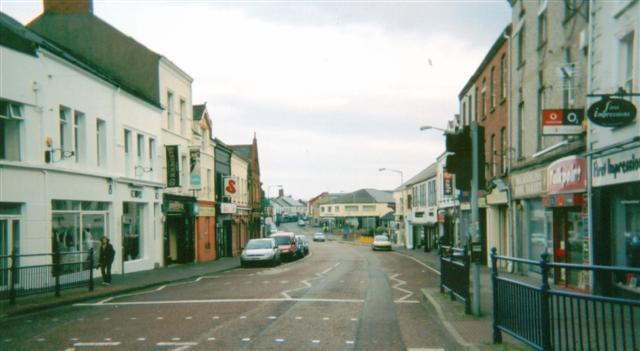
Railway Road, the bomb was planted in the right foreground
One
of the many people who helped the injured and dying that day
was a WWII veteran called Frank Walls, a former Battery
Sergeant Major in the Coleraine Battery. He gave first aid to
many victims and organised stretcher teams using doors taken
from the bombed out buildings to move the victims to the
ambulances.
Photo
26 Frank, Mary and ‘Toots’ Walls, 1942
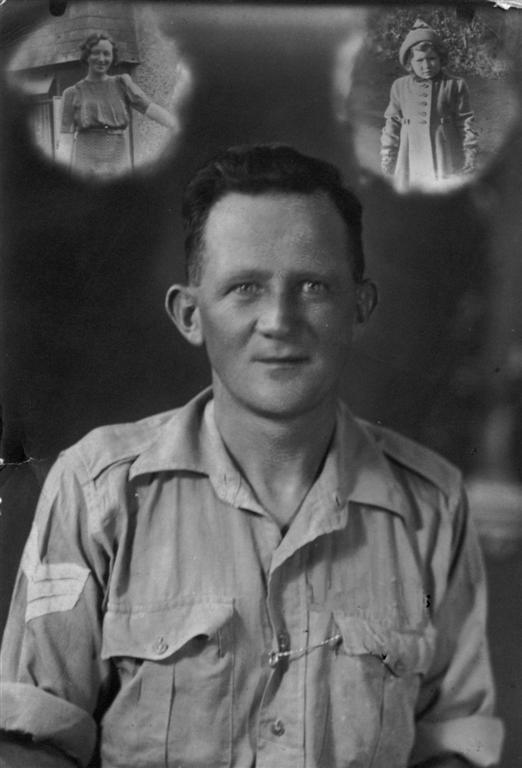
The
Sunningdale Agreement and the UWC Strike
The Sunningdale Agreement of December
1973 was a power sharing concept where Unionist and nationalists were persuaded to
work together and solve the political deadlock in Northern
Ireland. In response to the implementation of the Sunningdale
Agreement a Loyalist
ad hoc committee called the Ulster Workers Council (UWC) was
established. The UWC condemmed the Sunningdale Agreement and
conducted a two week General Strike starting on 15 May 1974.
The strike involved a combination of political,
paramilitary and popular support. Province wide the Loyalist paramilitaries used intimidation to enforce the strike. In
Coleraine town the ad hoc committee met in a Unionist
Councillor’s house. That committee was made up of councillors,
church ministers and trade Unionists who all gave ‘a nod and a wink’ to the paramilitary
leaders while discussing the blockade of the Coleraine roads.
This was a difficult time for E Company soldiers who had to run
the gauntlet of groups of ‘Loyalists’ on the River Bann
bridges. It was practically impossible to get petrol and
soldiers were allowed to buy Jerrycans of petrol from the Army
to enable them to travel to and from duty.
On 28 May
1974, in the second week of the strike, the power sharing
executive collapsed and direct rule was reintroduced.
After misjudging the attitudes of the Loyalist paramilitaries
during the UWC strike, Merlyn Rees, Secretary of State for Northern Ireland,
thought this was a good time to push Tom Nairn’s idea of
Ulster Nationalism. But the Loyalists wanted to maintain the Union . They were dissillusioned by
the inability of the Unionist politicians to capitalise on the power base presented to them
during the strike.
This strike proved to be the last time the Coleraine Loyalist
paramilitaries would fully co-operate with the Unionists.
Merlyn Rees and the Northern Ireland Office civil servants were
sowing the seeds of Ulster Nationalism on very stony ground.

Merlyn Rees visiting E Company Annual Camp at Ballykinlar 1974
The
Cell System
That same year, a series of
presentations on The Cell System were held throughout Northern Ireland.
Officers from the Ulster Defence Association (UDA) Co.
Londonderry command visited Coleraine and encouraged the local
UDA leaders to create secret terrorist groups of between four
to eight men who were prepared to conduct a clandestine murder
campaign against the IRA and their supporters. But sustained by
the success of the UWC strike the volunteers in Coleraine UDA
saw no value in breaking down their unit into smaller units.
It would be decades before the idea was finally adopted
by Loyalist paramilitaries such as the Ulster Freedom Fighters
and the Ulster Volunteer Force. The IRA did adopt the cell
system to a limited degree in 1977 to counter the covert
operations mounted against them by the security forces..
The
Coolkeeragh Power Station Raid
In
July 1975, E Company were tasked to guard Coolkeeragh power
station in Londonderry. That night intruders, who came in below
the perimeter fence, tied up the guard and stole six SLRs (Self
Loading Rifles).
A thorough investigation followed and it was found that
three of the platoon responsible for the guard duty that night
had Loyalist paramilitary connections.
The Coolkeeragh Guard Commander reported, “I was
fortunate or unfortunate to be in combat situations.
Once in Swatragh village there was a PIRA shooting
attack against our mobile patrols.
I am unable to recall any long-term pressure or stress
from these ‘contacts’, but there was one incident where my
patrol was held hostage in Coolkeeragh power station by a group
of armed Loyalist terrorists. That situation was more stressful
than the Swatragh incident. That was because the patrol was
being shot at in the Swatragh incident and your anti-ambush
drill training just kicks in. You know how to react to that
form of contact.
In the Coolkeragh situation we were being held by a
bunch of Loyalist terrorists and we had no control of the
situation. We could have been killed or injured and there was
nothing we could do. When I look back on that incident I know
that I prayed silently more that night than I have ever done
before or since.” S3.
John
Trussler
As
a measure of the calibre of the volunteers joining E Company,
consider the life history of John Trussler, who joined the
Company on 15 September 1975.
His military career started when he enrolled in the
Royal Artillery at Rhyl, North Wales on 5 January 1949. During
his gunnery career John has had postings to Borneo, Singapore,
Malta and BAOR (British Army of the Rhine).
He has been attached to 36th Heavy
Anti-Aircraft Regiment, Malta, 36th Guided Weapon
Rgt, 16th Light Air Defence (LAD), 102nd
Light Air Defence and 206 Light Air Defence Battery in
Coleraine. It was while serving with 102 LAD that he received
his first Royal Warrant on promotion to Sergeant Major PSI
(Warrant Officer 2nd Class Permanent Staff
Instructor).
On discharge from the Regular army he joined 206 LAD
Battery, Coleraine and received his second warrant as Sergeant
Major, Territorial Army Volunteer Reserve (TAVR).
On the 15 Sept 1975 John transferred to E Company as
Sergeant PSI and worked his way through the ranks again to
receive his third warrant as Sergeant Major. He was posted to
the Quartermaster’s Department in Battalion Headquarters and
later became the Training Warrant Officer of the Battalion
before retiring in 1982. John’s remarkable military career
has spanned 33 years.
Farrenlester
Road Explosion
“Four
Loyalist terrorists belonging to the UVF, Mark Dodd, Samuel Swanson,
Robert Freeman and Aubrey Reid
were killed in
a premature bomb explosion on the Farrenlester Road, near
Coleraine on 2 October 1975 when the
device they had been transporting blew up. I was in command of
the cordon on the Farrenlester Road between Coleraine town and
Macosquin village after the explosion” S10.
Long before the Farrenlester Road explosion the Rev
Brian Liddell had made a forthright statement from the pulpit
of 1st Coleraine Presbyterian Church in Coleraine.
He stated that he would never officiate at the funeral service
of any member of the congregation killed as a direct result of
their involvement in a terrorist act.
Rev Liddell did not conduct the funeral service for
Samuel Swanson. A
minister from another church was employed. The funeral
procession turned out to be the largest one that decade.
The
following Sunday, Rev Liddell reiterated his edict and went on
to say that any one who disagreed with his decision was free to
leave the church. Nobody left the church that day.
Search
Operation
The
following month, on the first Sunday in November, E Company
carried out a planned search of a wood near Dungiven. On the
search was an eager young Permanent Cadre soldier called Ronnie
Gamble. He had a habit of volunteering for such operations to
counter the dreary routine of Base Guard duties.
There were quite a few chuckles from others when the
soldier refused to take up the Mk 1 Prodder and instead
produced his personal electronic metal detector and started to
sweep the area designated to him. Within thirty minutes he
discovered expended cases close to a small reservoir, proving
that the area was used to test fire terrorist weapons.
The search intensified after that and E Company had two
more sets of finds that day including 140 assorted rounds of
ammunition, 30 ft of safety fuse and a tin of 93 commercial
detonators. This was one detailed example of many successful
search operations conducted by E Company. That was also the
month An Phoblacht presented an article on having Ulster
ethnically cleansed by the year 2000.
Opening
the New 5th (Co. Londonderry) Battalion Headquarters
Two
months later the Battalion Headquarters location was
transferred from Ebrington Barracks in Londonderry City to
Shackleton Barracks in Ballykelly. On 31 January 1976 Maj. Gen.
David Young presided at the official opening. He commented on
the Battalion strength being over 830 personnel including 62
female UDR with an average turnout of 250 soldiers every night
in County Londonderry.
The
Company Commander’s Daily Routine
“I
do not know how I managed to do it or how the other men managed
to cope with the workload. Most of the men were doing their
normal job during the day and reporting for duty several nights
every week and at weekends.
I was rising in the morning at 8am for breakfast. I then
called into the camp for a check on the situation with the
Company Sergeant Major and to pick up my mail. I then went off
to school. Sometimes I called into the camp at 1pm. After
school I was usually home for 5pm and immediately went to
sleep. My wife would wake me at 6pm for dinner and by 7:30pm I
would be back in the base.
At 8pm the patrols would be briefed and then head out on
patrol. Sometimes I would accompany the patrol. On other
occasions I would have to go to either Londonderry or
Ballykelly to attend an Operational Briefing (O Group) with all
the other senior officers. I would be back home in bed for 4am,
hopefully!
How I was capable of carrying out this punishing routine
for twelve years without a major health problem is beyond me.
In 1976 I was promoted and E Company changed command. I then
had a series of senior staff postings and retired at the age of
58 in 1982. The first six and a half years were terrible for
both my family and myself. After that, the next five and a half
years were not so bad.
From 1970 until 1976, we had progressed from a small
group of ex-servicemen and a few green recruits to a large
strong company, ready, capable and willing to serve anywhere.
It was a privilege to be part of it. You felt that you were
really needed – you did not always know the importance of the
job you were doing. Your men did not know what car bombs your
roadblocks had prevented.
On one occasion I can remember our roadblock obviously
stopped ‘something’. The car approaching us did a hand
brake turn. It was hard to tell your men you didn’t know
exactly what they were achieving. But they were doing a good
job in deterring the terrorist. We even caught some of them in
the commission of their evil crime. My motivation was always
loyalty to the Crown. I enjoyed service life, the atmosphere of
the Officers’ and Sergeants’ Mess and working with the
men” S1.
Change
of Company Commander
“I
took over command of E Company in July 1976 and concentrated on
improving recruit training and training for operations while
maintaining and strengthening all our operational commitments.
We had no difficulty in attracting new male recruits together
with ‘Greenfinches’ (female soldiers) and the Company grew
rapidly in size and strength. The age profile of the company
changed considerably in the late 70s and we had many more new
young men and women joining. This new influx provided
additional challenges and required much effort to ensure we
were operationally ready at all times. With the Detachment at
Garvagh the Company had a total strength of over 250 – almost
half a Regular army Battalion” (Hamill, 2007).
Photo
27 Major Victor Hamill
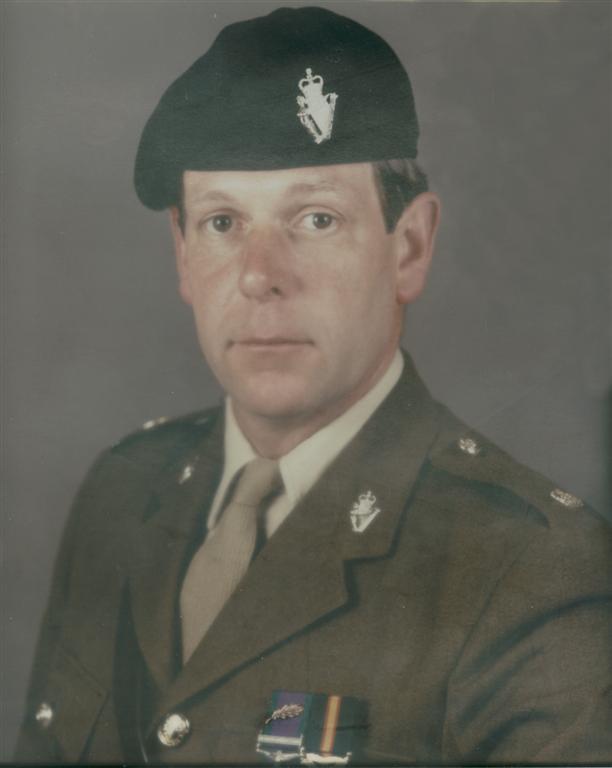
Police
Primacy
The
policy document ‘The Way Ahead’ was introduced in July 1976
and implemented in 1977. It discussed the Ulsterisation of
security in the Province, where the RUC were to take the lead
and the UDR replaced the regular army to provide patrol
operations throughout most of the Province.
The policy of Police Primacy led to many changes in the
Northern Ireland security scene. The full-time soldiers became
known as Permanent Cadre and their pay increased to be on
parity with the Regular army pay scales. There was also an
increase in recruiting and training in order to cope with the
ever-expanding patrol areas. The Tactical Area of
Responsibility (TAOR) of the UDR in all areas increased as the
Regular army was withdrawn and the Permanent Cadre took over
their patrol areas.
The full-time soldier sometimes worked in excess of
eighty hours each week. These figures were massaged in that
full-time Company Commanders stopped the clock when the patrols
were relieved on the ground. That deleted the time it took for
you to get back to base, return your equipment and get home.
This reduced your operational hours by five hours on some
duties.

Map
1 The Expanding TAOR
Alongside this overt change in tactics there was also an
increase in covert tactics where all terrorist suspects became
subject to more intense surveillance. The part-time element
also experienced many changes.
”Our
operations became more sophisticated and patrolling became much
more efficient and effective. As time went on the UDR developed
a closer working relationship with the RUC and joint patrols
became standard procedure.
The UDR input to supporting the RUC had a clear
advantage because of local ‘nouse’. There were exceptions
of course when frictions surfaced due to personality
differences on rare occasions or when the military approach
differed to the policing requirements. Any of these perceived
or real problems were always successfully overcome by
discussion or negotiation and by applying common sense and
decency.
Patrol tasks became our bread and butter as well as
guards and other duties and we became proficient in advanced
skills at section, platoon and company level. We operated
‘Framework Operations’ – mutually supporting patrols that
basically saturated an area and kept the terrorist guessing.
These were very successful tactics in preventing ambushes of
patrols and the free movement of terrorists and their
munitions” (Hamill, 2007).
Not only was there a radical change in Security Force
tactics, there was an equally radical change in Republican
terrorist tactics after the short IRA ceasefire ended in 1975.
In 1976/77 twenty-nine UDR personnel and thirty-seven RUC were
murdered. This rate was double that from the previous three
years. Eleven of the murdered UDR personnel were from 5 UDR
alone.
Increased
Terrorist Activity in 1976
E
Company soldiers managed to survive one of those murderous
attacks. At the start of August 1976, 21 Platoon had a close
call on Portballantrae Rifle Range in County Antrim. A milk
churn bomb was buried at one of the firing points and a
pressure plate was hidden on top of it so that anyone standing
on the firing point would detonate the bomb below.
“At
the start of the range day Sergeant George Mitchell and I were
making our way down to the butts for the first detail of the
March and Shoot firing practice. Corporal Robert McCarron and
another soldier were setting out six rounds of ammunition on
each firing point. Various teams were out on a forced march
that culminated in a competition shooting practice. When the
March and Shoot team arrived on the firing point they had to
charge their magazines with the ammunition and then engage the
targets.
Photo
28 Sgt George Mitchell

Sergeant
Mitchell and myself were about fifty metres from the firing
point when this blast came. It was like a heavy wind and we
felt this blast on the back of our legs. I looked round and saw
Corporal McCarron flying through the air. A soldier was lying
in the trench in front of the firing point screaming with his
face covered in blood.
As we ran back to the firing point Alex was already on
the scene supervising the first aid to the two injured
soldiers. He did a wonderful job under the circumstances.
Although the Private soldier looked the worst of the two
injured, all his wounds were superficial. Corporal McCarron had
sustained severe chest and jaw injuries. The surgeon at
Coleraine Hospital had to use pioneering techniques to
reconstruct Corporal McCarron’s jaw.
Corporal McCarron had stepped on the pressure pad. He
survived this Republican booby trap attack but was unfit for
service” (H Jamieson, 2007).
The
Republican onslaught continued and within a week of the
Portballintrae attack the commercial heart of Portrush town was
under attack.
“A
Republican terrorist arson bomb attack took place in Portrush
on Tuesday 6 August 1976.
This remains the top north coast resort and the ten-bomb
attack was designed to coincide with the peak of the holiday
season. We were on cordon duty all through the night and were
also tasked to search the town for unexploded IED’s” S10.
The following week on the 12 August 1976 E
Company were responsible for manning the PVCPs on the Muff,
Buncrana and Letterkenny roads as well as the checkpoint on the
Quayside. This was part of the Company’s contribution to the
Emergency Call Out of the UDR Province wide. It allowed the
Resident Battalion to monitor the crowds at the Apprentice Boys
parade in Londonderry city.
The Province and 5 UDR in particular suffered from
brutal attacks carried out by Republican terrorists from 1976
onwards. In March 1977 there was an emergency call out of UDR
personnel for a two-week period in order to curb the Republican
murder spree. The SDLP spokesperson on law and order protested
in the local press claiming that the call out was unwise.
The Unionist politicians called on the Government to
deal more effectively with the IRA and also reintroduce
majority rule.
They also set about organising a second Province wide
strike. One of the organizers was the Rev Ian Paisley and the
group was known as the United Unionist Action Council (UUAC).
That strike ran from Tuesday 3 May until Friday 13 May in 1977
and it proved to be an abject failure. This time there was no
general uprising of the Unionist and Loyalist family. The
Coleraine paramilitaries were not prepared to support political
leaders who, they believed, failed to capitalise on the
advantages they had gained for them in the 1974 UWC strike.
Despite threatening to resign if the second strike
failed Paisley carried on. A subsequent ‘show of force’ by
the DUP degenerated into the donning of cherry berets, climbing
a hill in a nice safe area and the waving of firearms
certificates at the invited media.
Visit
by the Queen August 1977 (Her Silver Jubilee Year)
Three
months later the Company was called out again for the Queen’s
visit on 10 and 11 of August 1977. E Company was tasked to
secure the coastline between Portstewart and Portrush,
particularly the area overlook in the anchorage of the Royal
Yacht Britannia. The Company Tactical Headquarters was
established in Portrush Town Hall. Twenty-one Platoon was based
in the harbour and used the Harbour Master’s office as a
Platoon Headquarters. Twenty-two and 23 Platoons patrolled
Portrush town and Garvagh detachment, 24 Platoon, provided
patrols on the town boundaries. The Company had the unique
responsibility of coordinating the deployment of over 400 men
and women from different army units in that security operation.
“At 4am on 11 August I decided to take a foot patrol
from Company Headquarters to the West Strand to ‘freshen
up’ for a visit by the Commanding Officer and the Brigade
Commander at 6am. We had no swimming gear for a dip in the sea
and as far as I know we were undetected. The Commanding Officer
and Brigade Commander thought we were very alert when they
arrived” (Hamill, 2007).
It was a sunny day when the Royal Yacht Britannia
and the escort ship arrived and anchored off the NW coast at
Portrush. There was a carnival atmosphere in the town. Two
local fishermen, Derek McLeister and Freddy Fleming set up a
barbeque in the harbour close to 21 Platoon Headquarters.
They barbequed fresh mackerel all day and the platoon
was well fed.
The Royal Marines patrolled the harbour area in their
fast patrol boats all day and occasionally called into the
harbour to enjoy pints of Guinness and beer as well as the
adulation of young boys and girls. Unfortunately E Company did
not have the same glamour but the general public did give them
a friendly pat on the back now and then for a job well done.
The security threat was minimal and the IRA seemed to have
boycotted the occasion.
Later on, the Queen visited the University of Ulster.
The SDLP boycotted the Coleraine visit. After her visit a bomb
exploded in the grounds of the University. In a follow-up
operation an army explosives search dog indicated an interest
in two different rooms of the University.
The
Killings after 1978
From
1978 onwards the ‘Ulsterisation’ of Northern Ireland
security did not result in more Ulster deaths but instead it
led to a spectacular reduction in some of the death rates. The
yearly average for civilians (117) and the Regular army (39)
dropped to forty-six and thirteen respectively. After 1991 the
killings dropped further to twenty-six and 2.5
Despite the upsurge in the murder of UDR/RUC personnel
in 1976/77 table 2 shows how this changed in 1978 to nine and
twelve respectively and finally dropped in 1991 to one and
three.
Table
2 Murder Victims Yearly Average
|
Phase |
Civilian |
Reg
Army |
UDR |
RUC |
|
1969
- 1977 |
117 |
39 |
11 |
12 |
|
1978
- 1990 |
46 |
13 |
9 |
12 |
|
1991
- 2001 |
26 |
2.5 |
1 |
3 |
When
the terrorist killings are attributed to their respective
groups they are also quite revealing. Table 3 shows that up
until 1977 the Republican terrorists were killing 96 people
every year and the Loyalists 48. After 1977 this figure dropped
to 60 and 12 respectively.
Table
3 The Terrorist Yearly Murder Rate
|
Phase |
Republicans |
Loyalists |
|
1969-1977 |
96 |
48 |
|
1978-1990 |
60 |
12 |
|
1991-2001 |
18 |
18 |
This
can be explained in part by the fact that Republican terrorists
had adopted the cell system in 1977 to counter the covert
operations mounted against them by the security forces. As well
as that the sectarian killers now had more political direction.
This helped to reduce the civilian deaths as the killers were
ordered to concentrate on the security forces. Despite this
political control of the Republican campaign the sectarian
atrocities did continue as the gunmen countered the Loyalist
murders with more ‘spectaculars’.
The drop in Loyalist murders can be related to the drop
in Republican murders so there were fewer ‘tit-for-tat’
attacks on Roman Catholics. At the same time the Intelligence
services had infiltrated all Loyalist groupings and
deliberately slowed down their kill rate. The Loyalist groups
at this stage were now more corrupt and were focused on
extortion, drug dealing and protection rackets. Then in 1991
the terrorists were on parity, each group murdering 18 people
every year.
Previous
Chapter 7 - Prelude
to Terrorism
Next
Chapter 9 - E
Company - The Middle Years - the 80s